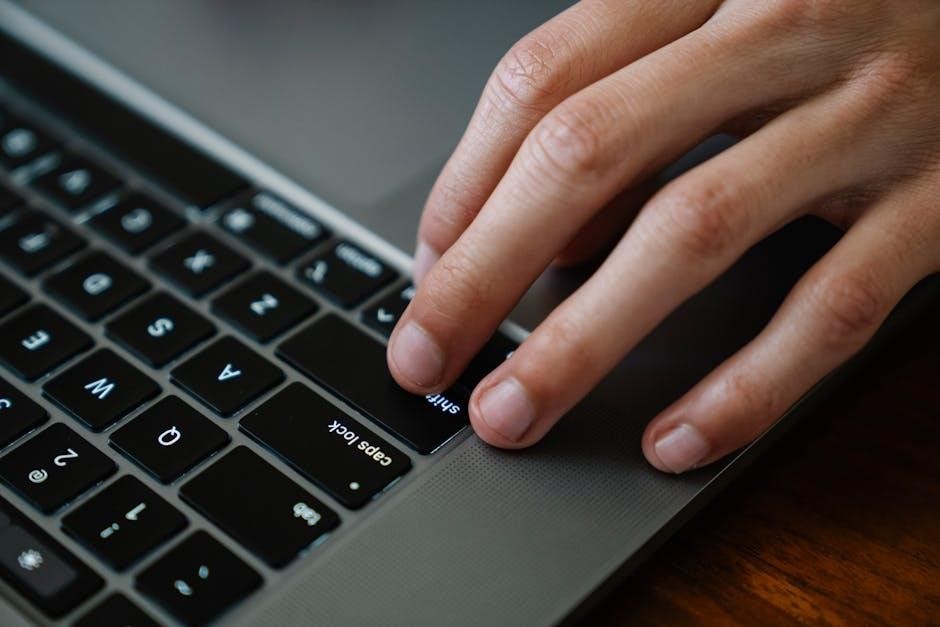Learning keyboard typing finger position is essential for efficient typing, using online resources and guides to master the skill, with proper hand placement and finger placement on keys.
Understanding the Basics of Keyboard Typing
To understand the basics of keyboard typing, it is essential to learn the fundamentals of typing, including the correct placement of fingers on the keyboard. The home row keys are the base position for typing, and fingers should be placed on these keys without looking at the keyboard. The left hand should be placed on the keys A, S, D, and F, while the right hand should be placed on the keys J, K, L, and ;. This positioning allows for efficient typing and reduces the risk of errors. By mastering the basics of keyboard typing, individuals can improve their typing speed and accuracy, making it an essential skill for everyday life. Proper finger placement and hand positioning are crucial for effective typing, and understanding these basics is the first step to becoming a proficient typist.

Proper Hand Positioning on the Keyboard
Hands should be positioned evenly on the keyboard with wrists straight and fingers curved gently over the keys for optimal typing comfort and efficiency.
Placing Fingers on the Home Row Keys
To start typing, fingers should be placed on the home row keys, which are the middle row of keys on the keyboard. The left hand should be placed on the keys ASDF, with the index finger on F, the middle finger on D, the ring finger on S, and the little finger on A. The right hand should be placed on the keys JKL;, with the index finger on J, the middle finger on K, the ring finger on L, and the little finger on;. This positioning allows for efficient typing and reduces strain on the hands and wrists. By placing fingers on the home row keys, typists can easily reach other keys and type quickly and accurately. Proper finger placement is essential for learning to type correctly and developing good typing habits.
The Importance of Finger Placement
Proper finger placement is crucial for efficient typing, reducing errors, and minimizing strain on hands and wrists with correct keyboard techniques always.
Assigning Fingers to Specific Keys
Assigning fingers to specific keys is a fundamental aspect of keyboard typing, as it enables individuals to type efficiently and accurately. The most common method involves assigning the index fingers to the F and J keys, while the middle fingers are assigned to the D and K keys. The ring fingers are typically assigned to the S and L keys, and the pinky fingers are assigned to the A and semicolon keys. This assignment allows for optimal hand positioning and finger movement, reducing fatigue and increasing typing speed. By following this assignment, individuals can develop muscle memory and improve their overall typing skills, making it an essential step in learning to type effectively. Proper assignment of fingers to keys is crucial for efficient typing and should be practiced regularly to develop good typing habits.

Typing Techniques for Efficiency
Mastering typing techniques improves efficiency, using online guides and tutorials to develop muscle memory and increase typing speed and accuracy with proper keyboard typing finger position methods.
Using the Ten-Fingers Technique for Touch Typing
The ten-fingers technique is a method of touch typing that involves using all ten fingers to type, with each finger assigned to a specific key on the keyboard. This technique is widely used and is considered to be the most efficient way to type, as it allows for fast and accurate typing. By using all ten fingers, the typist can type without looking at the keyboard, which improves speed and reduces errors. The ten-fingers technique requires practice and patience to master, but it is a valuable skill for anyone who uses a computer regularly. With online guides and tutorials, it is easy to learn and practice the ten-fingers technique, and to develop the muscle memory needed to become a proficient touch typist. This technique is essential for efficient typing and is used by professionals and individuals alike.

Benefits of Proper Keyboarding Position
Proper keyboarding position reduces strain and pain, improving overall comfort and productivity with correct posture and finger placement on keys always.
Reducing Strain and Pain while Typing
Reducing strain and pain while typing is crucial for individuals who spend extended periods typing on a keyboard. Proper finger placement and hand positioning can help alleviate discomfort and prevent injuries. By placing fingers on the home row keys and keeping wrists straight, typists can reduce the risk of developing conditions such as carpal tunnel syndrome. Additionally, taking regular breaks to stretch and move around can help prevent fatigue and discomfort. Online resources and guides provide tips and exercises to help individuals improve their typing posture and reduce strain. With practice and awareness, typists can develop healthy typing habits and avoid pain and discomfort. This can lead to increased productivity and overall well-being, making it an essential aspect of keyboard typing to consider and implement. Using a keyboard with an ergonomic design can also help reduce strain.
Keyboard Layout and Design
Keyboards have various layouts, including QWERTY, QWERTZ, and Dvorak, each with unique design features and finger positioning requirements for efficient typing and comfort.
Understanding the QWERTY Keyboard Layout
The QWERTY keyboard layout is the most widely used layout, with keys arranged to slow down typing to prevent mechanical jams in early typewriters.
The layout has become the standard due to its widespread use and muscle memory developed by users.
Keyboards with this layout have the keys arranged in a specific pattern, with the QWERTY sequence on the top left letter row.
This layout requires a specific finger positioning, with the left hand fingers on the A, S, D, and F keys, and the right hand fingers on the J, K, L, and ; keys.
The QWERTY layout is used in many countries and is the default layout for many computers and typing software.
Understanding the QWERTY layout is essential for learning proper typing techniques and improving typing speed and accuracy.
The layout is also used in many online typing games and tutorials, making it a fundamental part of learning to type.
The QWERTY layout has undergone minor changes over the years, but its basic structure remains the same.
The layout is still widely used today, despite the development of newer layouts, such as the Dvorak layout.
The QWERTY layout is an essential part of learning to type and is used by millions of people around the world.
Practicing Correct Typing Techniques
Regular practice with online typing games and exercises improves typing speed and accuracy using correct finger placement and hand positioning techniques daily.
Exercises for Improving Typing Speed and Accuracy
Typing exercises are essential for improving typing speed and accuracy, and can be found online in various formats, including interactive games and downloadable worksheets. These exercises typically involve typing drills, where the user is prompted to type a series of keys or words in a specific sequence. Regular practice with these exercises can help to develop muscle memory and increase typing speed and accuracy. Many online typing tutorials and guides also offer exercises and drills to help users improve their typing skills. By practicing regularly and using the correct finger placement and hand positioning techniques, users can significantly improve their typing speed and accuracy over time, making them more efficient and productive in their work and daily activities, and achieving their goals more easily.




